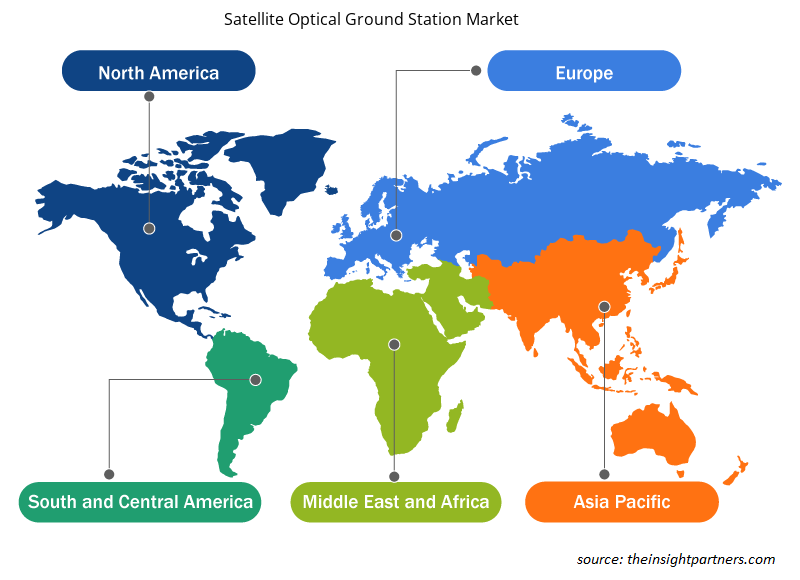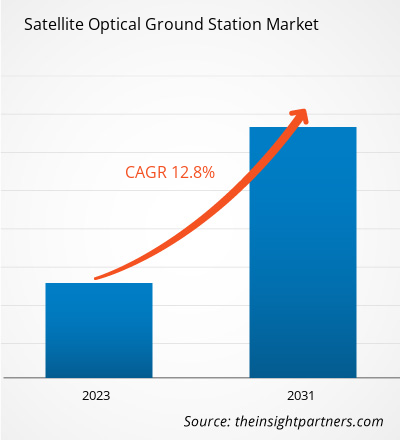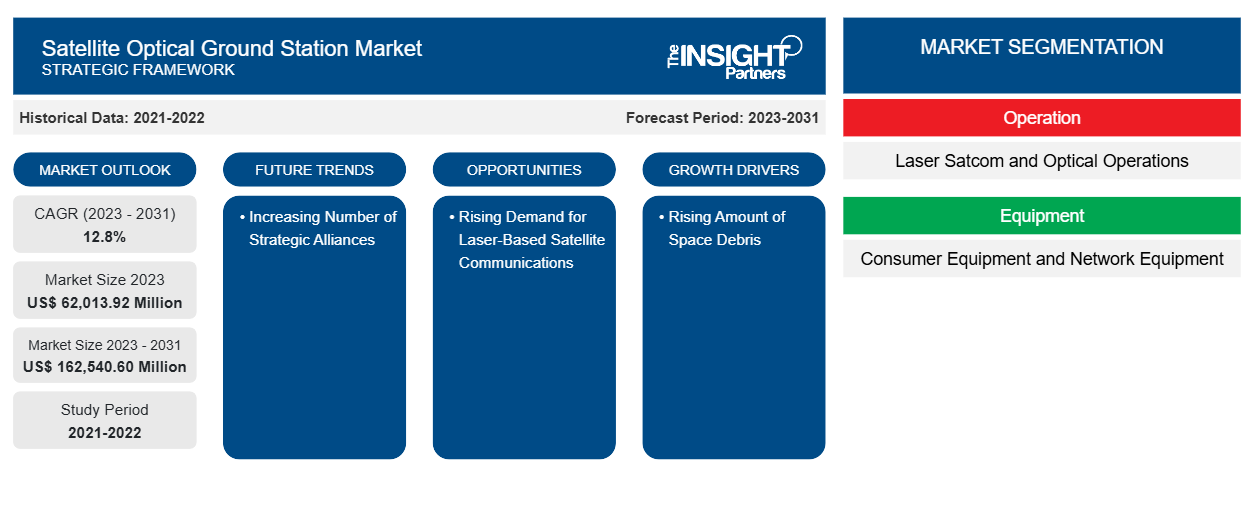Le marché des stations terrestres optiques pour satellites devrait atteindre 162 540,60 millions USD d'ici 2031, contre 62 013,92 millions USD en 2023. L'augmentation de la construction de nouveaux aéroports à travers le monde contribue à la demande accrue de solutions de réseau de communication. Le nombre croissant de lancements de satellites à l'échelle mondiale stimule la demande de stations terrestres optiques pour suivre et surveiller le mouvement des satellites et recevoir et transmettre simultanément des données. En outre, les OGS avancés suscitent une demande pour leur aide dans la surveillance de ces satellites. En outre, la demande d'OGS est propulsée pour éviter la menace de collision de débris spatiaux avec des actifs spatiaux fonctionnels. Les OGS contribuent également à garantir des activités spatiales sûres et durables conformes aux directives, normes et autres normes nationales et internationales.
Analyse du marché des stations terrestres optiques par satellite
Français Le nombre de lancements de satellites augmente à l'échelle mondiale en raison du besoin croissant de satellites dans diverses applications telles que l'observation de la Terre, la communication et la navigation, et la recherche scientifique. Selon plusieurs agences spatiales, en moyenne, environ 466 petits satellites ont été lancés par an entre 2012 et 2021, et ce nombre devrait augmenter à 1 846 petits satellites par an entre 2022 et 2031. Pour le lancement de ces 4 663 petits satellites entre 2012 et 2021, les gouvernements de divers pays et entreprises ont investi environ 23,1 milliards de dollars américains, et il est prévu qu'ils investiront encore 84 milliards de dollars américains entre 2022 et 2031. En outre, le nombre de lancements de fusées spatiales , principalement pour le déploiement de satellites dans l'espace, augmente également rapidement. Français En 2021, il y a eu 136 lancements de fusées réussis, alors qu'en 2022, ce nombre est passé à 180. En septembre 2022, on a constaté que 16 lancements orbitaux ont eu lieu, dont 8 en Chine, 6 dans les Amériques, et un en Europe et en Russie chacune. En outre, Falcon 9 a lancé 191 satellites à large bande Starlink et SpaceX a lancé 1 465 satellites Starlink en 2022. De nouveau, en janvier 2023, la Chine a lancé 14 satellites au sommet d'une fusée porteuse Longue Marche-2D depuis le centre de lancement de satellites de Taiyuan, dans la province du Shanxi, au nord de la Chine. Les 14 satellites comprenaient Qilu-2 et Qilu-3, Luojia-3 01 et Jilin-1 Gaofen 03D34. En février 2023, l'Organisation indienne de recherche spatiale (ISRO) a annoncé le déploiement réussi de trois satellites sur leurs orbites prévues via le véhicule SSLV-D2.
Aperçu du marché des stations terrestres optiques par satellite
Une station terrestre optique (OGS) est un élément essentiel de l'infrastructure qui relie l'espace à la Terre. Le système permet de fournir des communications en temps réel pour diverses applications à des débits de données beaucoup plus élevés (jusqu'à plusieurs Gbps) que la RF. Le besoin croissant de données à plus haute résolution pour les missions qui nécessitent que les scientifiques obtiennent une vue détaillée de la Terre et du système solaire entraîne une forte demande de systèmes OGS. Le système permet également de fournir de grands volumes de données pour répondre aux exigences de la mission et localiser les actifs au sol en fonction des paramètres d'orbite de la mission. Ainsi, la demande d'OGS augmente à l'échelle mondiale pour une plus grande précision et un transfert de données à grande vitesse.
Personnalisez ce rapport en fonction de vos besoins
Vous bénéficierez d'une personnalisation gratuite de n'importe quel rapport, y compris de certaines parties de ce rapport, d'une analyse au niveau des pays, d'un pack de données Excel, ainsi que de superbes offres et réductions pour les start-ups et les universités.
-
Obtenez les principales tendances clés du marché de ce rapport.Cet échantillon GRATUIT comprendra une analyse de données, allant des tendances du marché aux estimations et prévisions.
Moteurs et opportunités du marché des stations terrestres optiques par satellite
Augmentation du nombre de débris spatiaux
Tous les matériaux artificiels non fonctionnels en orbite autour de la Terre à différentes altitudes peuvent être qualifiés de débris spatiaux. Les débris comprennent les pièces de fuselage de fusée, les débris de fragmentation, les déchets créés lors de missions habitées, les produits d'échappement des fusées et les satellites hors service. La plupart de ces débris gravitent autour de la Terre à une vitesse moyenne supérieure à 26 000 km/h en orbite terrestre basse (LEO), ce qui constitue une grave menace de collision pour les actifs spatiaux fonctionnels. Ces menaces augmentent à chaque lancement de fusée pour LEO et l'espace lointain. Les menaces croissantes de collision d'objets spatiaux constituent un problème persistant pour l'utilisation sûre et durable de l'espace extra-atmosphérique. Ces menaces restreignent l'accès sans entrave à l'espace et incitent les parties concernées à prendre les mesures nécessaires pour atténuer les risques. En novembre 2021, l'armée russe a effectué un test antisatellite (ASAT) et a fait exploser son satellite hors service Cosmos 1408 (qui a été lancé en 1982) avec un missile Nudol. Immédiatement après l'explosion, les astronautes américains et russes à bord de la Station spatiale internationale ont dû prendre des mesures préventives pour éviter d'être heurtés par les débris du satellite, car la Station spatiale internationale était censée être raisonnablement proche du satellite. En juin 2022, la Station spatiale internationale a de nouveau dû entreprendre une manœuvre d'évitement de collision (CAM) pour éviter les débris orbitaux du satellite détruit. Un vaisseau cargo sans équipage Progress 81 a été utilisé par l'agence spatiale russe Roscosmos pour éloigner la station spatiale de la trajectoire des débris. En 2021, l'ISRO a effectué 19 CAM, contre 12 et 8 CAM en 2020 et 2019, respectivement.
Nombre croissant d’alliances stratégiques
La demande croissante de stations terrestres optiques pour satellites encourage les entreprises à développer des solutions avancées pour l'expansion de l' industrie spatiale . Pour cette expansion, les gouvernements de différents pays et les acteurs de tous les secteurs industriels investissent continuellement dans la R&D. Ils privilégient diverses alliances stratégiques, telles que des partenariats, des collaborations et des contrats, dont quelques-uns sont mentionnés ci-dessous :
• En mars 2023, CONTEC a annoncé avoir choisi Cailabs pour fournir une station terrestre optique qui sera installée en 2024. Cette nouvelle station terrestre optique intégrera le composant TILBA-ATMO pour des communications fiables et à haut débit. De plus, la station terrestre sera compatible CCSDS, SDA et QKD.
• En février 2023, l'Agence spatiale rwandaise (RSA) a annoncé un partenariat avec ATLAS Space Operations Inc. pour construire une infrastructure terrestre de satellites au Rwanda. Dans le cadre de cet accord, RSA construit un téléport capable d'héberger plusieurs stations terrestres pour desservir des satellites sur différentes orbites.
• En septembre 2022, Safran Data Systems a annoncé avoir signé un contrat avec CONTEC pour la livraison d’une station sol optique qui sera installée en Australie occidentale. Safran livrera une station sol optique (OGS) clé en main, qui sera composée d’une monture offrant une couverture optimale, d’un télescope de 50 cm, d’un système complet de pointage, d’acquisition et de poursuite, et d’un dôme rotatif.
• En septembre 2022, SSC a annoncé que l'Agence spatiale européenne (ESA) lui avait attribué un contrat de 1,09 million de dollars (1,1 million d'euros) pour soutenir le développement du projet de communication optique Network of Optical Stations for Data Transfer to Earth from Space (NODES). Dans le cadre de ce contrat, SSC a passé commande auprès de Cailabs pour la livraison d'une station terrestre en Australie occidentale, dont les essais devraient commencer début 2024.
Ainsi, par le biais de contrats et de partenariats, diverses entreprises travaillent à la fourniture de stations terrestres optiques avancées, qui devraient offrir des opportunités de croissance potentielles pour le marché des stations terrestres optiques par satellite au cours de la période de prévision.
Analyse de segmentation du rapport sur le marché des stations terrestres optiques par satellite
Les segments clés qui ont contribué à l’élaboration de l’analyse du marché des stations terrestres optiques par satellite sont l’exploitation, l’application, l’utilisateur final et l’équipement.
- En termes d'exploitation, le marché des stations terrestres optiques par satellite est divisé en deux catégories : les communications par satellite laser et les opérations optiques. Les solutions comprennent des logiciels tels que le réseau Smartsky, le réseau Iridium, SITA connect et AirportHub. Le segment des opérations optiques détenait la plus grande part de marché en 2023.
- En termes d'application, le marché des stations terrestres optiques pour satellites est segmenté en opérations laser, identification des débris, observation de la Terre et connaissance de la situation spatiale. Le segment de l'observation de la Terre détenait une part de marché plus importante en 2023.
- En fonction de l'utilisateur final, le marché des stations terrestres optiques par satellite est divisé en deux segments : les entreprises gouvernementales, militaires et commerciales. Le segment gouvernemental et militaire détenait une part de marché plus importante en 2023.
- En termes d'équipement, le marché des stations terrestres optiques par satellite est segmenté en équipements grand public et en équipements de réseau. Le segment des équipements de réseau détenait une part de marché plus importante en 2023.
Analyse des parts de marché des stations terrestres optiques par satellite par zone géographique
Le marché nord-américain des stations terrestres optiques pour satellites est segmenté entre les États-Unis et le Canada. Les technologies avancées de stations terrestres optiques pour satellites sont largement adoptées aux États-Unis et au Canada pour améliorer les capacités de défense. En août 2020, le Centre spatial américain a annoncé que l'United Launch Alliance (ULA) avait été chargée de lancer ses missions spatiales essentielles à la sécurité nationale pour l'US Space Force. Les missions devraient être déployées depuis la base aérienne de Cap Canaveral en Floride au cours de l'exercice 2027. Ces types de lancements de satellites contribuent à l'adoption des technologies de stations terrestres.
En outre, le lancement de nouvelles stations terrestres de satellites dans la région et l’expansion des stations terrestres existantes sont d’autres facteurs majeurs qui stimulent la croissance des stations terrestres optiques de satellites dans la région nord-américaine. Par exemple :
• En 2022, BlueHalo a remporté un contrat d'une valeur de 1,4 milliard de dollars américains auprès de l'US Space Force pour la mise à niveau de 12 stations terrestres militaires à travers le pays, où BlueHalo remplacera les anciennes antennes paraboliques par des antennes à réseau électronique à commande de phase dans les stations terrestres militaires.
• En février 2023, l'opérateur de satellites KSAT a annoncé qu'il étendait son réseau avec l'installation de nouvelles antennes de stations au sol à travers l'Antarctique et qu'il étendait sa capacité aux États-Unis grâce à plusieurs antennes à Hawaï, en Alaska et dans le sud-est des États-Unis.
• En janvier 2023, Starlink de SpaceX a annoncé le lancement de sa flotte de satellites de deuxième génération et l'expansion de son infrastructure de stations au sol à travers les États-Unis.
• En mai 2019, GigaSat, qui fait partie d'Ultra Electronics Communications & Integrated Systems (CIS), en partenariat avec Inmarsat, a livré 16 terminaux de stations terrestres multibandes par satellite au ministère de la Défense nationale (MDN) du Canada.
Ces évolutions devraient catalyser la croissance des stations terrestres de satellites dans la région. En outre, la croissance du nombre de lancements de satellites est un autre facteur majeur susceptible de générer de nouvelles opportunités pour les fournisseurs du marché au cours de la période de prévision.
Aperçu régional du marché des stations terrestres optiques par satellite
Les tendances et facteurs régionaux influençant le marché des stations terrestres optiques par satellite tout au long de la période de prévision ont été expliqués en détail par les analystes d’Insight Partners. Cette section traite également des segments et de la géographie du marché des stations terrestres optiques par satellite en Amérique du Nord, en Europe, en Asie-Pacifique, au Moyen-Orient et en Afrique, ainsi qu’en Amérique du Sud et en Amérique centrale.

- Obtenez les données régionales spécifiques pour le marché des stations terrestres optiques par satellite
Portée du rapport sur le marché des stations terrestres optiques par satellite
| Attribut de rapport | Détails |
|---|---|
| Taille du marché en 2023 | 62 013,92 millions de dollars américains |
| Taille du marché d'ici 2031 | 162 540,60 millions de dollars américains |
| Taux de croissance annuel composé mondial (2023-2031) | 12,8% |
| Données historiques | 2021-2022 |
| Période de prévision | 2023-2031 |
| Segments couverts |
Par opération
|
| Régions et pays couverts |
Amérique du Nord
|
| Leaders du marché et profils d'entreprises clés |
|
Densité des acteurs du marché : comprendre son impact sur la dynamique des entreprises
Le marché des stations terrestres optiques par satellite connaît une croissance rapide, tirée par la demande croissante des utilisateurs finaux en raison de facteurs tels que l'évolution des préférences des consommateurs, les avancées technologiques et une plus grande sensibilisation aux avantages du produit. À mesure que la demande augmente, les entreprises élargissent leurs offres, innovent pour répondre aux besoins des consommateurs et capitalisent sur les tendances émergentes, ce qui alimente davantage la croissance du marché.
La densité des acteurs du marché fait référence à la répartition des entreprises ou des sociétés opérant sur un marché ou un secteur particulier. Elle indique le nombre de concurrents (acteurs du marché) présents sur un marché donné par rapport à sa taille ou à sa valeur marchande totale.
Les principales entreprises opérant sur le marché des stations terrestres optiques par satellite sont :
- Thales SA
- Société de balle
- AAC Clyde Space AB
- Hensoldt AG
- Systèmes aéronautiques General Atomics Inc.
- Tesat-Spacecom GmbH & Co KG
Avis de non-responsabilité : les sociétés répertoriées ci-dessus ne sont pas classées dans un ordre particulier.

- Obtenez un aperçu des principaux acteurs du marché des stations terrestres optiques par satellite
Actualités et développements récents du marché des stations terrestres optiques par satellite
Le marché des stations terrestres optiques par satellite est évalué en collectant des données qualitatives et quantitatives après des recherches primaires et secondaires, qui comprennent d'importantes publications d'entreprise, des données d'association et des bases de données. Voici une liste des développements sur le marché des innovations, de l'expansion commerciale et des stratégies :
- En avril 2023, HENSOLDT AG, acteur majeur de l'industrie de la défense européenne, a été promu au MDAX, l'indice des valeurs moyennes de la Bourse de Francfort. L'entreprise, qui est entrée en bourse en septembre 2020, a poursuivi sa croissance de manière constante et a continuellement accru sa force d'innovation. Elle a augmenté ses investissements, élargi son portefeuille de produits et réalisé des acquisitions stratégiques dans le monde entier. (Source : HENSOLDT AG, communiqué de presse)
- En avril 2023, Ball Aerospace, Loft Federal et Microsoft se sont associés pour travailler sur le programme de banc d'essai expérimental de la Space Development Agency (SDA), appelé NExT, pour mettre en orbite 10 satellites avec des charges utiles expérimentales. Ball Aerospace est le maître d'œuvre, dirigeant l'intégration et les tests des charges utiles et des engins spatiaux. Loft Federal effectuera l'intégration et les tests des engins spatiaux, achètera des services de lancement commercial et exploitera la constellation en orbite. Parallèlement, Microsoft fournira à Azure Government une infrastructure cloud et une station terrestre avec des opérations satellite sécurisées après le lancement et des solutions de productivité pour piloter les communications critiques pour la mission. La collaboration vise à établir un pipeline de livraison rapide indépendant des fournisseurs pour permettre le succès de la mission de SDA. (Source : Ball Aerospace, communiqué de presse)
Rapport sur le marché des stations terrestres optiques par satellite : couverture et livrables
Le rapport « Taille et prévisions du marché des stations terrestres optiques par satellite (2021-2031) » fournit une analyse détaillée du marché couvrant les domaines suivants :
- Taille et prévisions du marché des stations terrestres optiques par satellite aux niveaux mondial, régional et national pour tous les segments de marché clés couverts dans le cadre.
- Dynamique du marché, comme les facteurs moteurs, les contraintes et les opportunités clés
- Tendances du marché des stations terrestres optiques pour satellites
- Analyse détaillée des cinq forces de PEST/Porter et SWOT
- Analyse du marché des stations terrestres optiques par satellite couvrant les principales tendances du marché, le cadre mondial et régional, les principaux acteurs, les réglementations et les développements récents du marché
- Paysage du marché des stations terrestres optiques par satellite et analyse de la concurrence couvrant la concentration du marché, l'analyse de la carte thermique, les principaux acteurs et les développements récents.
- Profils d'entreprise détaillés
- Analyse historique (2 ans), année de base, prévision (7 ans) avec TCAC
- Analyse PEST et SWOT
- Taille du marché Valeur / Volume - Mondial, Régional, Pays
- Industrie et paysage concurrentiel
- Ensemble de données Excel
Rapports récents
Témoignages
Raison d'acheter
- Prise de décision éclairée
- Compréhension de la dynamique du marché
- Analyse concurrentielle
- Connaissances clients
- Prévisions de marché
- Atténuation des risques
- Planification stratégique
- Justification des investissements
- Identification des marchés émergents
- Amélioration des stratégies marketing
- Amélioration de l'efficacité opérationnelle
- Alignement sur les tendances réglementaires























 Obtenez un échantillon gratuit pour - Marché des stations terrestres optiques par satellite
Obtenez un échantillon gratuit pour - Marché des stations terrestres optiques par satellite